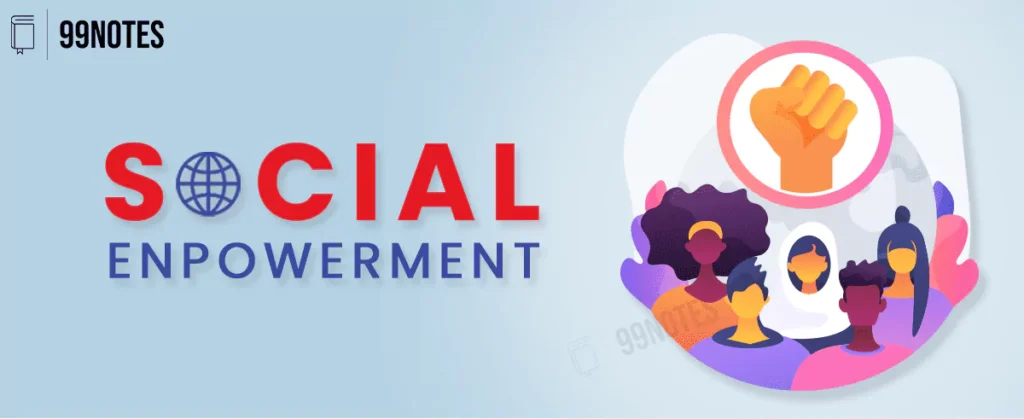
Social Empowerment UPSC Notes Free Download
Social Empowerment
What is Social Empowerment?
Social empowerment refers to the process of enabling individuals and communities to have more control over their lives and to participate more fully in the social, economic, and political systems that affect them. It involves addressing issues of inequality, discrimination, and exclusion, and promoting the development of social and human capital.
There are various approaches to social empowerment, including:
- Education: Providing education and training opportunities can help individuals and communities develop the skills and knowledge needed to participate fully in society and to take advantage of economic opportunities.
- Economic empowerment: Providing access to financial resources and economic opportunities can help individuals and communities become more economically independent and self-sufficient.
- Political empowerment: Promoting political participation and representation can help individuals and communities have a greater say in the decisions that affect their lives and communities.
- Social inclusion: Promoting social inclusion and addressing issues of discrimination and exclusion can help individuals and communities feel more connected and valued within society.
- Health: Improving access to healthcare and addressing health disparities can help individuals and communities lead healthier, more productive lives.
There are many other aspects of social empowerment that you may wish to study, such as gender equality, disability rights, and environmental justice. It is important to understand the underlying issues and root causes of inequality and to develop a holistic approach to addressing them.
Social Groups at Risk
- Tribes Listed
- Scheduled Castes Women
- Minorities
- Rural Areas’ Population
- Senior citizens
- People with Disabilities (Divyang’s)
Social Issues
Scheduled Tribes experience the following issues:
1. Forest-related difficulties – The forest is the foundation of the tribal community’s way of life. They continued to enjoy their traditional rights of hunting, gathering, and shifting agriculture, but the advent of modern government, under the guise of forest conservation, restricted ST movement, calling their existence into doubt. Moreover, their land is seized for a pittance by government agencies and the private sector.
2. Poverty and exploitation – Due to their naiveté, the tribal people is exploited and forced into a cycle of poverty. They have lived in woods since the dawn of time, but as the government enforced limits, many of them became exploited slave labourers. 52% of STs in India live below the poverty line (BPL), and 54% lack access to economic resources such as communication and transportation (World Bank, 2011).
While literacy is much higher among north-eastern and island tribes, the north-eastern region also has a high dropout rate and an elevated newborn mortality rate.
Due to poverty, lack of proper drinking water, inadequate sanitation, a lack of health services, superstition, and deforestation, PVTGs suffer from a range of health problems, including anaemia, malaria, gastrointestinal ailments, vitamin deficiencies, and skin diseases.
3. Agriculture – Agriculture contributes to poverty in states such as MP and Chhattisgarh, along with natural disasters, crop failure, restricted access to land, and a lack of employment, among other factors.
4. High unemployment rates exist among the island’s indigenous tribes. STs experience forced migration, exploitation, and displacement as a result of industrialization, which has led to a loss of ownership over natural resources, and they are unable to adjust to the changing labour and resource patterns.
5. More Dependence on Minor Forest Produce – Minor Forest Produce (MFP) is the primary source of income for forest-dwelling indigenous populations. The majority of MFP-related operations remained disorganised in nature.
Scheduled Castes experience the following difficulty:
Numerous critical amenities, including access to drinking water, temple admittance, public transit, and burial, were prohibited to the SCs.
- Despite numerous breakthroughs, the existence of social impairments remains a grim reality.
- The majority and other components of society periodically abuse the scheduled caste’s human rights.
- They were forced to forage for food, work as slave labourers, and engage in other activities that violated their fundamental human rights.
- Hindus have barred reserved castes from acquiring an education for centuries, and this tradition persists today.
- In educational institutions, they have received unjust treatment.
- Scheduled castes are usually refused access to temples because they are still regarded as untouchables (Gandhi Ji called them “Harijan”).
- These impairments are more prevalent in rural areas than to urban areas.
Minorities in India face the following challenges:
When community riots or conflicts occur, the minority’s interests are compromised.
After the 1960s, the incidence of social disturbance began to increase.
Due to the severity and regularity of communal disturbances, the minority is losing trust in the system, and it will be exceedingly challenging for the government to restore that faith.
Identity as a Challenge
- Due to differences in sociocultural customs, history, and ancestry, minorities must struggle with the problem of identity.
- Consequently, the problem of assimilating into the dominant society emerges.
- The Security Predicament
- Different identities develop feelings of insecurity over their lives, possessions, and well-being due to their relative rarity in compared to the rest of society.
- This feeling of uneasiness may be increased when relations between the majority and minority populations in a society are tense or not particularly cordial.
- The problem of underrepresentation in politics and government:
- Despite the fact that the Indian Constitution promises equality and equal opportunities to all citizens, including religious minorities, the biggest minority group, Muslims, have not exercised these fundamental human rights.
Women experience the following issues:
- Domestic Violence And Dowry Deaths : Dowry deaths are the murder or suicide of married women by their husbands and in-laws as a result of chronic harassment and torture over a dowry dispute, making their homes the most hazardous location for them. Families continue to be the greatest threat to women. “Cruelty by spouse and family” is the most prevalent sort of serious crime against women, accounting for 36% of all instances.
- Pink-collar job categorization: In general, women are seen suitable for “pink-collar work,” including teachers, nurses, receptionists, babysitters, lecturers, and other stereotypically female-only positions. This limits their possibilities in other areas.
- Early marriage: especially for females, limits their options and stops them from becoming powerful. Particularly in rural areas, girls do not receive timely nutrition and healthcare help. As a result, malnutrition and anaemia among Indian girls are among the highest in the world. Even if education were permitted, the girl would be unable to attend classes owing to the constraints imposed by homework.
- Glass ceilings: In India, women suffer artificial hurdles like as stereotypes, media-related concerns, informal limits that hinder them from progressing through the ranks of their companies to positions of management.
- In India, women’s political engagement is low: just 11.8% of the Indian Parliament and 9% of state legislatures are comprised of women. Despite the fact that the 73rd constitutional amendment legislation stipulates the reservation of 33 percent of panchayat seats for women. Patriarchal society and gender discrimination a Prevalence of “Sarpanch Pati” A patriarchal culture is one in which males rule, and gender inequity develops when one sex is given primacy over the others. Discrimination is also evident in education as male children attend prestigious schools but female children do not.
- Unemployment: The provision for unemployment has been characterised by uneven treatment of women throughout its history. In several industries, women are not favoured despite the fact that they are frequently paid less.
- A digital literacy gap : In India, females make up less than one-third (29%) of all Internet users. This is a significant gender difference.
- In disadvantaged nations, women are 12% less likely than males to utilise the internet.
Social Group At Risk (Vulnerable Group):
The Vulnerable Group faces multiple and complex factors of Vulnerability with different layers compared to others. The Group in society often encounter discriminatory treatment and other issues in the society which are as follows:
Challenges Faced by Divyaang:
Divyaang is oppressed, marginalized, and denied the opportunity for full participation and to live a reasonable quality of life because of society’s persistent stereotypical and prejudiced perception of them as inferior, incapable, inadequate, and a burden on family resources and society. They experience the following challenges:
- Their disability is often seen as an “inability” many person, and people, in general, have preconceived notions about their capabilities.
- Most of the buildings in India are not disability friendly, despite the government’s Accessible India campaign, etc.
- Lack of good and Accessible medical facilities results in various medical complications for both the unborn child and pregnant mother, often leading to a disability for the child.
- Lack of availability of assistive and adaptive technology and devices.
- Lack of accessibility and adaptability in the workspace is a hindrance to disabled people.
Challenges faced by senior Citizens:
Though ageing is the natural stage of human life, it brings numerous problems for elderly people. A detailed analysis of the major problems of the elderly people are as follows:
- With superannuation, a person has to retire from the service, which results in the loss of employment and income level, making them economically insecure.
- Older people suffer from different sorts of physiological problems, such as loss of physical strength and stamina, which become more acute as a person grows older.
- With the changing dynamics of modern societies, families are becoming nuclear, and the traditional support systems are gradually decreasing, eventually leading to feelings of loneliness and social isolation.
- With increasing crime rates and the Vulnerability that comes with age, senior citizens are often targeted by fraudsters, burglars, and scam artists. This constant fear can lead to stress and anxiety.
- Multiple illnesses and physical ailments accompany ageing. Apart from physical illness, the aged people are more likely to be victims of deteriorated mental health, which arises from senility, neurosis and extent of life satisfaction.
- Elder abuse is usually defined as any ill-treatment of an older person, which is also increasing gradually.

